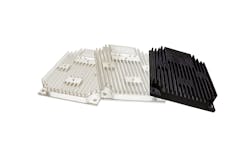New Materials Open 3D Printing Doors
The 3D printing industry never sits still. Our mission to democratize the industry by making reliable, productive machines means the printers we have on the market are more like time machines than production technologies. To make 3D printing feasible in every manufacturing business, we need both accelerated 3D printer technology and robust and predictable materials.
3D printing opens up more possibilities than any other production technique. But this is only true when the material options are broad, and with so many platforms on the market, this is not the case.
Closed systems close doors. To achieve high productivity, performance, and production consistency while driving down waste, 3D printing companies and material manufacturers need to collaborate. Tailoring materials to the 3D printing process requires chemicals, materials, and 3D printing experts having unadulterated access to the platform the materials are being designed for.
A Shining Partnership
Nexa3D recognized the symbiosis between materials development and advancing printer technology early on. For this reason, we have formed close partnerships with materials and chemical companies like Henkel, DSM, Evonik, and BASF. Because there are so many polymer techniques used in plastics printing, plus so many applications, the more we join forces the better.
The latest development in materials innovation comes in the form of three ultrafast photopolymers. We expanded our partnership with BASF to combine our ultrafast 3D printing capabilities with BASF’s rapidly expanding suite of polymers.
The benefits will be felt in companies designing housings, enclosures, pipes, packaging, and footwear who can now rapidly design a broader range of parts, while maintaining robust performance characteristics.
Three New Photopolymers
The first is the x45-Natural, a tough material ideal for models and functional prototypes with high strength and durability. With short processing times, x45-Natural’s draft build mode provides greater manufacturing flexibility.
The second is the x45-Clear, which combines clarity with toughness for a range of models and functional prototypes that require fast turnaround times.
Finally, the x45-Black has an attractive black matte finish that makes it ideal for automotive parts traditionally molded using black plastic. Naturally, it provides good build speed and flexibility.
All three are capable of speeds of 220 mm per hour, feature excellent out-of-printer properties, and robust print styles that ensure high first-time build success. The three new materials will be available through Nexa3D’s distribution network globally.
“We are excited to expand our partnership with Nexa3D as we believe that the BASF 3D Printing Solutions portfolio of photopolymeric materials are well-matched for the high throughput of the NXE400 system,” said Francois Minec, Managing Director, BASF 3D Printing Solutions. “We look forward to continuing to deliver an expanded portfolio of materials across Nexa3D’s expanding portfolio of photoplastic (SLA) and thermoplastic (QLS) design and manufacturing solutions.”
Learn more about these materials here.
Joining Forces
Nexa3D wants 3D printing to thrive. That’s why we created and maintained an open materials platform. We are fulfilling our mission to democratize scalable polymer solutions for the entire product lifecycle, from design to production. Our NXE400 platform can deliver a 20x increase in speed and an 85% lower cost of ownership, while producing functional parts at injection molding quality, with comparable repeatability and tolerances. The rest of the industry needs to follow suit and open up platforms, form partnerships, and embrace the symbiosis between materials and machines.

